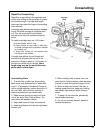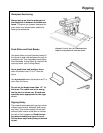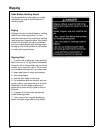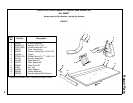
38
Ripping
7. Remove workpiece from table.
8. Ready push stick or push block.
9. Set up table extension(s) and support
their outer ends. Do not use another per-
son to support workpieces because this
can cause kickback and it exposes helper
to potential hazards at outfeed side.
Special Notes for Bevel Set-Up
CAUTION
Bevel ripping creates unique problems
of visibility and feeding. Before cut-
ting, check the set-up using both in-rip
and out-rip. Use the position that gives
the best combination of workpiece vis-
ibility and push stick clearance.
WARNING
Bevel the edge that is not against the
fence.
1. When setting bevel angle, raise radial
arm to allow sufficient clearance for blade
and guard to not jam in table.
2. When blade is beveled manually raise
clear plastic guard before lowering blade to
table or kerf, otherwise it may jam in the
table.
3. To set hold down, place workpiece
directly under guard nose, rather than paral-
lel to blade.
4. To set pawls, place workpiece directly
under set of pawls closer to table. This set of
pawls will keep contact with workpiece sur-
face.
Making Rip Cuts
Follow these steps to make in-rip cuts. For
out-rip cuts, reverse hand functions; that is,
put right hand on table and use left hand to
support and push workpiece.
1. Follow ripping set-up procedure.
In-Ripping


















